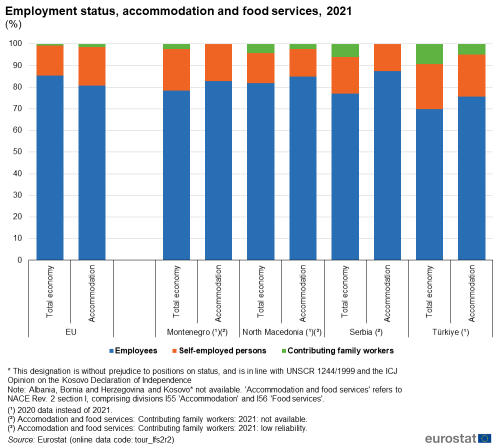Enlargement countries - tourism statistics
Data extracted in May 2023.
Planned article update: May 2024.
Highlights
There were more than 1.9 million bed places in hotels and similar establishments across Western Balkans and Türkiye in 2021, with 1.7 million in Türkiye alone. In comparison, there were 12.1 million in the EU.
The number of hotel bed places grew in all Western Balkans and Türkiye from 2011 to 2021, (available data).
In 2021 almost 30.9m tourists arrived at hotels in Western Balkans and Türkiye, 26% less than 41.6 million arrivals in 2019 (Serbia not included), still 2.2 times more than 2020, due to Covid-19 pandemic and associated travel restrictions.
Arrivals of non-residents at hotels and similar establishments, 2020 and 2021 (arrivals per thousand inhabitants)
This article is part of an online publication and provides information on a range of tourism statistics for the for the Western Balkans and Türkiye and compares this with the corresponding data for the European Union (EU). Within this region, Bosnia and Herzegovina, Montenegro, North Macedonia, Albania, Serbia and Türkiye are candidate countries, while Kosovo* has the status of potential candidate.
Data for Georgia, Moldova and Ukraine, granted candidate status or European perspective by the European Council in June 2022, are not included in this article; Statistics Explained articles on the European Neighbourhood Policy-East countries are available here.
This article highlights recent developments concerning the capacity of the tourism sector in these countries, in terms of the number of bed places available in hotels and similar accommodation establishments, the number of arrivals of non-residents at tourist accommodation establishments and the number of trips made by outbound tourists. It also provides data on different aspects of employment in the tourism sector, more specifically within the ‘Accommodation’ sub-sector.
Tourism plays an important role because of its economic and employment potential, as well as its social and environmental implications. Tourism statistics are not only used to monitor tourism policies but also regional and sustainable development policies.
* This designation is without prejudice to positions on status, and is in line with UNSCR 1244/1999 and the ICJ Opinion on the Kosovo Declaration of Independence.
Full article
Tourism infrastructure
There were more than 1.9 million bed places in hotels and similar establishments across the Western Balkans and Türkiye in 2021; 89 % of these were in Türkiye
The number of bed places available in hotels and similar tourist accommodation establishments provides one measure of a country’s capacity to attract tourists. In this context, it should be noted that official tourism statistics include business travellers as tourists, alongside individuals travelling for pleasure or other reasons. In 2021, the tourism sector in Western Balkans and Türkiye offered a combined total of more than 1.9 million bed places. By comparison, there were 12.1 million bed places in hotels and similar establishments across the EU in 2021. In Türkiye alone, there were 1.7 million bed places available, 89.0 % of the total among these countries. The second largest capacity was found in Albania with 85 000 bed places, corresponding to 4.5 % of the total, and the third highest found in Serbia (53 000; 2.8 %). The capacity of bed places was relatively at the similar level in Bosnia and Herzegovina (33 000) and North Macedonia (24 000), with Kosovo* at around half of this level (12 000).

(thousands)
Source: Eurostat (tour_cap_nat) and national data (see the section on Data sources)
The number of hotel bed places offered increased in all the Western Balkans and Türkiye in the decade from 2011 to 2021; no 2021 data available for Montenegro.
Throughout the decade from 2011 to 2021, Türkiye was by far the largest supplier of tourism capacity, in terms of the number of bed places available in hotels and similar accommodation, among the WBT countries. However, Türkiye is also a much larger country than the others. As can be seen in Figure 1, in 2021 the tourism sector was much more important in Montenegro (59.5 bed places per thousand inhabitants) and Albania (30.2) than in Türkiye (19.9), when the capacity in bed places in hotels are measured relative to the population size. Measured like this, the tourism sector also had higher importance in the EU (27.1) than in Türkiye. All these countries, as in the EU, can offer tourism in mountain regions as well as in coastal regions with beaches, in addition to sites of historical and cultural interest, thus offering a wide range of tourism types. The relative capacity of bed places was at a lower level in North Macedonia (12.5), Bosnia and Herzegovina (both 9.5), Serbia (both 7.7), as well as Kosovo (6.6).
By 2021, compared to 2011, the number of bed places relative to the population size had increased in all of the Western Balkans and Türkiye with Montenegro the only exception with a decrease by 9 % from 65.7 bed places per thousand inhabitants in 2011 to 59.5 in 2019 (no later data available).
In contrast, the bed place capacity in Albania increased by almost 5 times or 362 % from 6.5 in 2011 to 30.2 in 2021. Thus, from having almost the lowest capacity of bed places relative to the population in 2011, Albania had the second highest capacity among these countries (both relative to the population and in absolute numbers) in 2021. In addition to an increased interest in Albania as a tourist destination, this apparent increase reflected efforts by the government to formalise the economy and stimulate the tourist accommodation sector. A value added tax reform in November 2017 reduced the VAT rate applicable to tourist accommodation services from the standard 20 % VAT rate to 6 %. However, in order to benefit from the reduced rate, the tourist accommodation services had to be registered in separate companies without other economic activities. The threshold for compulsory VAT registration was also lowered from ALL 5 million to ALL 2 million turnover per calendar year. As a result, many bed places not previously captured by the statistics were registered from 2018, creating a break in the time series.
In comparison, the relative capacity in the EU increased by 5 % from 25.8 to 27.1 over the same period.
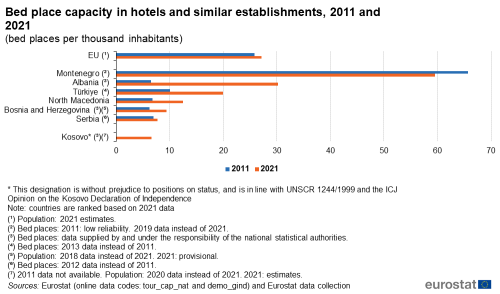
(bed places per thousand inhabitants)
Source: Eurostat (tour_cap_nat), (demo_gind) and national data (see the section on Data sources)
Figure 2 shows that the number of bed places in the Western Balkans and Türkiye followed quite different development paths throughout the decade 2011-2021. North Macedonia was the only country to experience an increase in the number of bed places for each year of this period. All the other countries experienced years in which the number of bed places declined, particularly in the early years of this period.
In Montenegro, an initial sharp fall by -15.0 points from 2011 to 2012, was followed by the period 2016 to 2019, when the bed places index fluctuated, with year-on-year changes ranging between -0.4 points (2018) and +2 (2017) compared to 2011; in 2019 (latest year available) the bed places index increase was at 1.7 from previous years.
The number of bed places offered specially decreased compared with the previous year in both 2012 and 2013 in Albania; the same applied Bosnia and Herzegovina in 2012, and Kosovo in 2018 (data only available from 2016 onwards). A striking feature is the sharp drop in the number of bed places offered in Bosnia and Herzegovina from 2019 to 2020, by -29 points, which may reflect the first effects of the Covid-19 pandemic on accommodation capacity. In 2011 Albania had the second lowest number of tourist accommodation bed places among the WBT countries relative to its population size. Thus, relative moderate year-on-year changes in the number of bed places resulted in relatively large year-on-year swings in the index based on the 2011 number. In 2012, the index fell by -16 points and -26 points in 2013, before rising again by 16 points in 2014. Following a break in data availability in 2016-2017, the November 2017 tourism accommodation-specific VAT tax reform had a profound effect on the registration of tourist accommodation bed places, implying a sharp break in the index time series. The index value jumped from 79 in 2015 to 411 in 2019, which is 5.5 times higher. The index value continued to grow rapidly, up 21.0 points from 2019 to 2020 and a further 15 points from 2020 to 2021. These index values (411 in 2019; 432 in 2020; and 447 in 2021) are too high to be presented in Figure 2.
The number of bed places in hotel accommodation remained relatively stable in Serbia (index: 2012 = 100.0) throughout the decade 2012-2021, with the index value moving within the range 110 (2013) to 105 (2021). The most substantial changes were a rise by 10 points from 2012 to 2013, which was countered by less essential falls by -3 points in the following year and by -2 points between 2014 and 2018.
In Türkiye, the index of bed places offered (2013 = 100.0) recorded small increases between 2013 and 2014 by 8 points, followed by a steep increase by 58 points between 2014 and 2016. Continued by substantial increase by 26 points in 2017, the index rose again by 5 points in 2018 and continued to increase at a more moderate pace until 2019 showing bigger rises between 2019 and 2020 - by 8 points and 2020 and 2021 - by 12 points.
The index on bed places for Bosnia and Herzegovina fell by -12 points from 2011 to 2012. In the following years, the offer of tourist accommodation bed places grew steadily, with year-on-year rises each year, with two-digit increases in 2013 (11 points), 2016 (14 points) and 2017 (11 points). However, from 2019 to 2020, a sharp drop was recorded in the index (-30 points), possibly reflecting the first effects of the Covid-19 pandemic on the supply of tourist accommodation. It was followed by rather substantial rise between 2020 and 2021 by 19 points.
For Kosovo, data on the number of bed places available in tourist accommodation establishments are available from 2016 onwards. These were the lowest numbers recorded in WBT countries in 2016-2021. As a result, relatively moderate changes in the absolute number of bed places were reflected in major swings in the index, which is based on 2016 for Kosovo (2016 = 100.0). The index was at the same level in 2017 and then fell year-on-year by about 3 points from 2017 to 2018, before rising by 8 points the following year. Then the level flatlined and remained unchanged in 2020 before rising by almost 3 points in 2021.
The number of tourist accommodation bed places offered in the EU grew slowly throughout the period 2011 to 2019, with the index value increasing by between 0.3 points (2016) and 1.6 points (2019) year-on-year. However, from 2019 to 2020, the index fell by -3.8 points; again, this could be a sign of a negative effect of the Covid-19 pandemic on tourism. However, it started to recover and showed a moderate rise by 2.0 points in 2021.
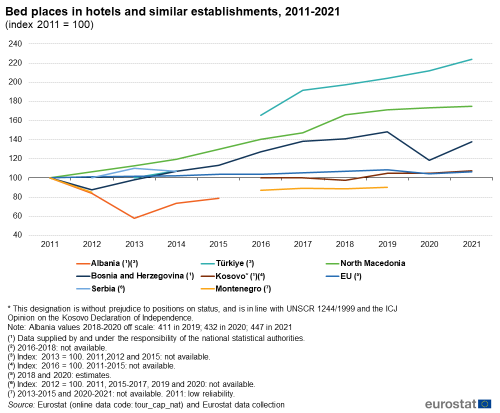
(index 2011 = 100)
Source: Eurostat (tour_cap_nat) and national data (see the section on Data sources)
Non-resident arrivals
Almost 30.9 million non-residents arrived at hotels and similar establishments in Western Balkans and Türkiye in 2021, up by 2.2 times or 123 % compared to the year before and down by 28 % compared to pre pandemic 2019 (Serbia was not accounted)
In 2021, there were 30.9 million arrivals of non-residents at hotels and similar establishments across the Western Balkans and Türkiye (see Table 2). This represented a fall by 28 % compared to 2019, when there were 41.6 million arrivals but also a rise by 123 % compared to 2020, when strict restrictions on travel and tourism were introduced in most countries due to the Covid-19. Between 2020 and 2021 all the Western Balkans and Türkiye recorded a sharp increase in the number of non-resident tourists arriving at hotels and similar establishments; all countries except of Serbia recorded more than 100% rise. Bosnia and Herzegovina recorded the highest increases of -156 %, with North Macedonia (148 %) experienced also almost 150% rise. Both Albania and Türkiye, which have by far the largest tourism sectors among these countries, experienced a slightly lower increases in arrivals of non-residents, by 133 % and 123 %, respectively. Albeit slightly less, a trend of growth of the number of arrivals by 113 % in Kosovo and 98 % in Serbia happened between 2020 and 2021.
The number of arrivals of non-residents had been growing steadily in Türkiye, from 14.2 million arrivals in 2016 to 38.8 million in 2019, followed by a fell to 12.8 million in 2020, before rising up to 28.5 million in 2021. This corresponded to 92.3 % to all arrivals of non-residents in the Western Balkans and Türkiye in 2021. Serbia recorded a fall from 1.1 million arrivals in 2016 to 392 000 in 2020 and then rose to 776 000 in 2021. Bosnia and Herzegovina reported a similar trend, from 1.1 million in 2019 to 189 000 in 2020 and reached 485 000 in 2021. There is no recent data for Montenegro, the number of non-residents’ arrivals had been growing from year to year from 524 million in 2011 to 795 000 in 2017. Albania recorded 656 000 arrivals in 2021 (down from 736 000 in 2019 and up from 281 000 in 2020), North Macedonia 284 000 (down from 725 000 in 2019 and up from 115 000 in 2020) and Kosovo 181 000 (up from both periods: 177 000 in 2019 and 85 000 in 2020).
In comparison, there was a total of 112 million arrivals of non-residents at hotels and similar establishments in the EU in 2021; 2,8 times down from 316 million in 2019 and almost 35% more than 83 million (2020 data).
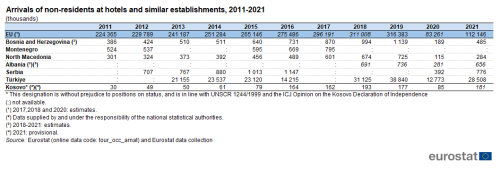
(thousands)
Source: Eurostat (tour_occ_arnat) and national data (see the section on Data sources)alt= A table showing the arrivals of non-residents at hotels and similar establishments from 2011 to 2021 in Kosovo, Albania, Bosnia and Herzegovina, Türkiye, North Macedonia, Montenegro, Serbia, and the EU.
Figure 3 compares the number of arrivals of non-residents at hotels and similar establishments relative to the number of (resident) inhabitants between 2011 and 2021. In order to better reflect the extraordinary effects of the Covid-19 pandemic on tourism in 2020, Figure 3 also includes 2020 data for direct comparison. Relative to the population, the tourism sector had the highest importance in Türkiye, which previously recorded a dramatic fall from 2019 to 2020, from 285 to 153, respectively; but absolutely recovered in 2021 with 342 arrivals per thousand inhabitants, a value 20% higher than in 2011. The arrivals of non-residents also strongly increased in Albania from 2020 to 2021 (from 99 to 231 – no data for 2011), in Bosnia and Herzegovina from 2011 to 2021 (from 101 to 139), in Serbia (from 98 to 113) and in Kosovo (from 17 to 101). North Macedonia was the only country where the number of non-resident arrivals per thousand inhabitants was lower in 2021 (137) than it had been in 2011 (146), but was still rather higher than in 2020 (55). Montenegro showed 1279 arrivals per thousand inhabitants in 2017 (latest data available), an increase of 51% compared to 2011.
In the EU, there were 251 arrivals of non-residents per thousand inhabitants in 2021 up from 186 in 2020. In 2011, the EU had welcomed 509 arrivals of non-residents per thousand inhabitants 2 times more than in 2021.
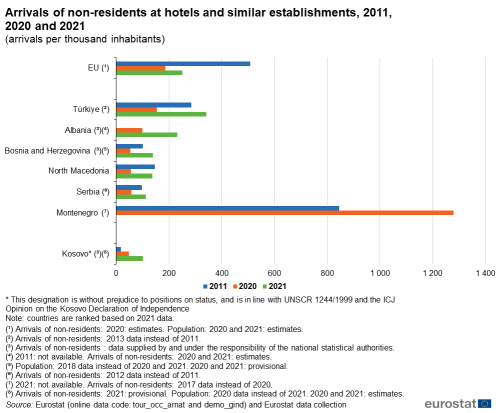
(arrivals per thousand inhabitants)
Source: Eurostat (tour_occ_arnat), (demo_gind) and national data (see the section on Data sources)
The index based on 2011 data on the number of arrivals of non-resident at hotels and similar, presented in Figure 4, shows the development in the Western Balkans and Türkiye from 2011 to 2021. Generally, the trend was upwards year-on-year, with only some instances of decline compared to the previous year.
The sharp falls in arrivals from 2019 to 2020, a direct effect of the Covid-19 pandemic through the restrictions imposed on travelling and on accommodation of tourists and other travellers, can be clearly seen for all WBT countries, with large drops for all. Particularly stark falls can be seen for North Macedonia (-84 %) and Bosnia and Herzegovina (-83 %). There were also dramatic falls in tourist arrivals, although not quite as sharp, in Türkiye (-67 %), Albania (-62 %) and Kosovo (-52 %). However, it should be noted that the number of arrivals in Kosovo already fell in 2019; thus, there may have been additional factors contributing to the sharp decline for Kosovo.
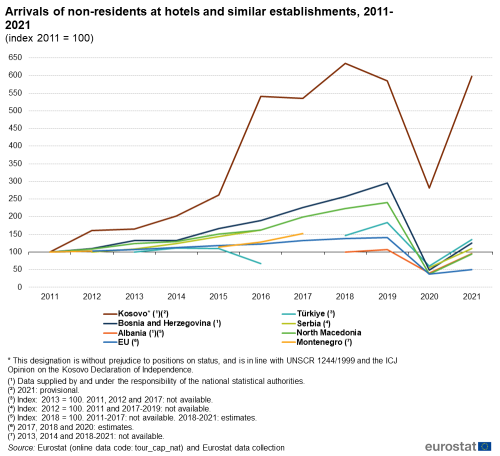
(index 2011 = 100)
Source: Eurostat (tour_occ_arnat) and national data (see the section on Data sources)
Outbound tourism
Tourists and other travellers from Türkiye made 2.7 million outbound trips in 2021
Table 3 presents the most recent available data on the outward flow of tourists travelling abroad from the Western Balkans and Türkiye and from the EU. Data are not available for the potential candidates Bosnia and Herzegovina and Kosovo.
Among the five candidate countries, the highest number of outbound tourist trips was recorded for Türkiye, the most populous of these countries, with 2.7 million in 2021. There were 846 000 outbound trips made by tourists from Serbia (2018 data), 291 000 from Albania (2020 data) and 261 000 from North Macedonia.
Considering the share of the population that went on outbound tourism trips shows a quite different picture. The highest share of the population going abroad on tourism trip among the data available was recorded in of North Macedonia with 18.2 % in 2019 and 13.4 % in 2021 of the population going on such trips. At lower level was Albania, with 36.2 % in 2019 and 10.3% in 2020. The population Serbia (12.1 %; 2018 data) and Türkiye (11.7 % in 2019 and 3.3% in 2021) also went abroad to a lower degree.
The EU was the destination for around two thirds of the outbound trips made by the inhabitants of most of these countries. Tourists from Serbia travelled to an EU Member States on 69 % (2018 data) of their outbound trips; in Albania this share was 47 %(2020 data) and in North Macedonia 41 %. Data on where the trips were going, whether to the EU or to other parts of the world, are not available for Türkiye. There are no data available for Bosnia and Herzegovina Montenegro and Kosovo.
EU tourists made 134 million non-domestic trips in 2021; 81 % of these trips, or 109.3 million trips, went to other EU Member States. Note that EU data for this indicator are estimates and only refer to persons aged 15 years or older.
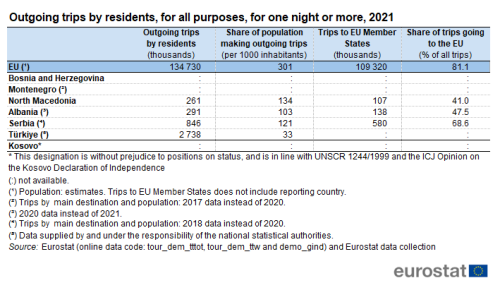
Source: Eurostat (tour_dem_tttot), (tour_dem_ttw), (demo_gind) and national data (see the section on Data sources)
Employment in the tourism sector
In Montenegro, North Macedonia, Serbia and Türkiye, there were fewer self-employed persons in accommodation and food services than in the general economy. In the EU, the opposite was the case.
The tourism sector is an important source of employment in many regions, also within the Western Balkans and Türkiye. Figure 5 shows the different categories of persons employed (employees; self-employed persons; contributing family workers) in the overall economy and compares this with a key section of the tourism sector: accommodation and food services activities (NACE Rev. 2 Section I). This section comprises accommodation (NACE Rev. 2 division I.55), covering hotels and similar establishments as well as other holiday and short-stay accommodation and camping grounds and recreational vehicle parks, and food services activities (NACE Rev. 2 division I.56), covering restaurants and mobile food services, event catering and other food services, as well as serving of beverages.
Data on the characteristics of the persons employed in the tourism sector are available for the EU and EU Member States as well as for the candidate countries Montenegro, North Macedonia, Serbia and Türkiye through the Labour force survey (LFS).
In all four countries for which data are available, the rates of self-employed persons and of contributing family members are lower in accommodation and food services than in the general economy.
Türkiye had the highest share of self-employed persons in accommodation and food services among these countries. However, the share of 19.3 % was lower than in Türkiye’s general economy (21.0 %; 2020 data, the latest available). This is the same for contributing family members; the share in accommodation and food services of 5.0 % in 2020 was the highest among these four candidate countries, but lower than the share of 9.2 % in the economy as a whole. It should be noted that data on contributing family members in accommodation and food services are available only for North Macedonia and Türkiye, but not for Montenegro and Serbia.
The second highest rate of self-employed persons in accommodation and food services was recorded in Montenegro, with 17.1 % in 2020 (no 2021 data), 2.0 percentage points (pp) lower than in the general economy (19.1 %). Data on contributing family members are not available for accommodation and food services, but stood at 2.4 % in the economy as a whole (2020 data).
North Macedonia had a level of self-employed persons in accommodation and food services of 12.7 % (2020 data); in comparison, this rates stood at 13.9 % in the general economy of North Macedonia. In North Macedonia, 2.4 % of the persons employed in accommodation and foodservices were contributing family members, compared to 4.3 % in the economy as a whole (2020 data).
It was closely followed by Serbia with 12.6 % in 2021 while the general economy rate was at 17.0 %. Data on contributing family members are not available for accommodation and food services, but accounted 6.0 % in the economy as a whole.
In contrast, in the EU there was a higher rate of self-employed persons and a higher rate of contributing family members in accommodation and food services than in the general economy. In 2021, 17.8 % of the employed in accommodation and food services in the EU were self-employed, while 1.4 % were family members. In the general economy in the EU, these rates stood at 13.8 % and 0.7 %, respectively.
The tourism sector is often characterised by high seasonality, with the level of employment varying over the year. This may lead to a relatively high share of temporary employment contracts (also known as fixed-term contracts or limited contracts) for the persons employed in this sector. From the LFS, data are available on this aspect for the accommodation sector for Montenegro, North Macedonia, Serbia and Türkiye, as well as for the EU.
In Türkiye and North Macedonia (both 2020 data), only a small minority of the persons employed in the accommodation sector has a temporary (limited) employment contract. In both cases, the share of temporary contracts was close to the overall shares in the economy. In Türkiye, the share with a temporary contract was 11.6 %, compared to 10.8 % in the economy as a whole, while in North Macedonia the shares were 16.7 % in the accommodation sector and 17.8 % in the general economy.
In contrast, in Serbia the share of the employed with only a temporary contract was nearing one third (30.3 %) in the accommodation sector in 2021. This was substantially higher than in the economy as a whole, where the share of temporary contracts was 7.4 pp less at 22.9 %. However, the largest difference in the prevalence of temporary contracts were recorded in Montenegro, where 41.1 % of the employed in the accommodation sector had only a limited employment contract in 2020, 10.5 pp higher than in the general economy (30.6 %).
In the EU, almost one quarter (23.9 %) of the employees in the accommodation sector had a temporary employment contract in 2021. In comparison, only 14.1 % of the employed in the general economy had to cope with a temporary employment contract, a difference of 9.8 pp.
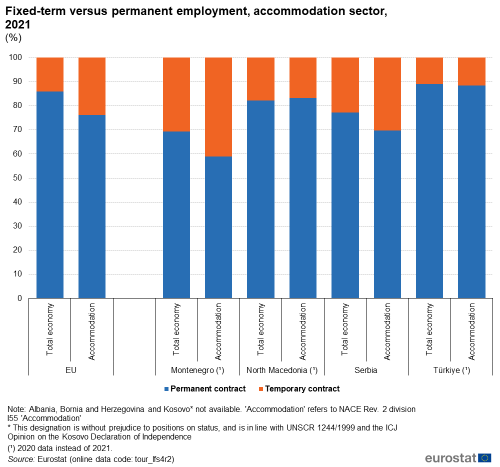
(%)
Source: Eurostat (tour_lfs4r2)
In the tourism sector, there is in many cases a quite high turnover of the persons employed, reflected in a relatively large share of persons employed that have stayed less than two years in their current job with the same employer and within the same NACE Rev. 2 economic activity. There may be different reasons for this, including the salary level, the extent of limited contracts, the seasonality of the work, or job security in cases of external shocks such as the Covid-19 pandemic. Figure 7 presents data on the tenure, i.e. the length of time an employee has been with the same employer, in the accommodation sector and compares this to the corresponding data for the whole economy.
Türkiye stands out among these countries, with 43.1 % of the persons employed in the accommodation sector having spent less than 2 years at their current work place (2020 data). However, this is a general feature of the Turkish economy; 39.4 % of persons employed had stayed less than 2 years in their current job, a difference of just 3.7 pp.
The difference between the accommodation sector and the general economy was much more profound in Serbia and Montenegro. In both countries, almost a third of the persons employed in the accommodation sector had less than 2 years tenure with their current employer, considerably higher than the average in their respective economies: while a tenure of less than 2 years concerned 32.9 % of the employees in the accommodation sector in Serbia in 2021, this share was 25.3 % in the general economy, a difference of 7.6 pp; in Montenegro, the difference was even larger; the rate in the accommodation sector (32.1 %; 2020 data) was 11.0 pp higher than in the economy as a whole (21.1 %).
In North Macedonia, there was little difference between the accommodation sector and the general economy: while 23.4 % of the employed had stayed less than 2 years with their current employer in general, it was 23.1 in the accommodation sector (2020 data).
In 2021, nearly one third (31.5 %) of the employed in the accommodation sector in the EU had worked less than 2 years in the same activity for the same employer, while this was case for almost one quarter (23.0 %) of the employed in general.
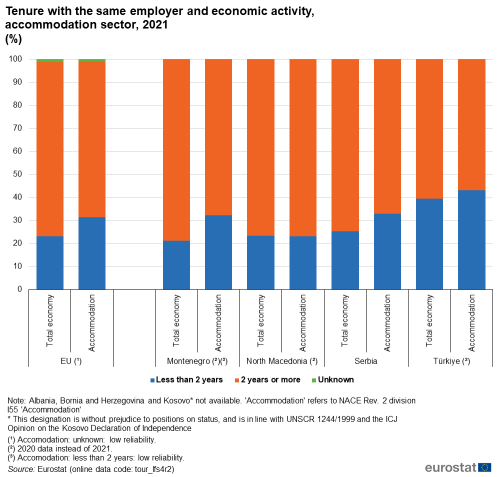
(%)
Source: Eurostat (tour_lfs5r2)
Source data for tables and graphs
Data sources
The enlargement countries are expected to increase the volume and quality of their data progressively, and to transmit these data to Eurostat and the wider ESS in the context of the EU accession process. The final objective of the EU in relation to official statistics is to obtain harmonised, high-quality data that conforms to both European and international standards. More details on the statistical aspects of the accession process can be found in the article Enlargement policy and statistical cooperation.
The enlargement countries are not at the same level of development and are progressing towards an efficient and modern statistical system at different speeds. In a number of areas, candidate countries (and sometimes also potential candidates) are in a position to provide harmonised data in accordance with the EU acquis with respect to methodology, classifications and procedures for data collection and the principles of official statistics as laid down in the European statistics Code of Practice. In these cases, the candidate countries (and potential candidates) concerned report their data to Eurostat following the same procedures and under the same quality criteria as the EU Member States and the EFTA countries. Data from the enlargement countries that meet these quality requirements are published along with data for EU Member States and EFTA countries.
In addition, the enlargement countries provide data for a wide range of indicators for which they do not yet fully adhere to the quality requirements specified in the EU acquis and the methodology, classifications and procedures for data collection specified in the relevant Regulations, Directives and other legal documents. These data are collected on an annual basis through a questionnaire sent by Eurostat to the candidate countries or potential candidates. A network of contacts has been established for updating these questionnaires, generally within the national statistical offices, but potentially including representatives of other data-producing organisations (for example, central banks or government ministries). This annual exercise also offers an opportunity to provide methodological recommendations to the enlargement countries. Data collected through this specific data collection from the candidate countries or potential candidates are signified as ‘"national data"’ in the tables and figures of this article.
Tourism, in a statistical context, refers to the activity of visitors taking a trip to a destination outside their usual environment, for less than a year. It can be for any main purpose, including business, leisure or other personal reasons other than to be employed in the place visited. A tourist is a visitor that stays overnight (at least one night).
Within the EU, a system of tourism statistics was established through Council Directive 95/57/EC of 23 November 1995 on the collection of statistical information in the field of tourism. This legal basis required EU Member States to provide a regular set of comparable tourism statistics. The Directive was amended in 2004 and 2006, before being repealed in 2011 when the European Parliament and the Council of the European Union adopted Regulation (EU) No 692/2011 concerning European statistics on tourism. The 2011 Regulation on tourism statistics was amended in 2013, in 2019 and again in 2020; the current consolidated version of Regulation (EU) No 692/2011 incorporate all these amendments.
Information concerning the current statistical legislation on tourism can be found here.
Tourism statistics in the EU consist of two main components: on the one hand, statistics relating to capacity and occupancy (supply-side tourism statistics); on the other, statistics relating to tourism demand. In most EU Member States, the former are collected via surveys filled in by accommodation establishments, while the latter are mainly collected via traveller surveys at border crossings or through household surveys. Statistics on tourism demand refer to tourist participation, in other words, trips of at least one overnight stay during the reference period.
Although the Western Balkans and Türkiye produce some of these statistics on tourism capacity, occupancy and tourism demand and provide these to Eurostat, tourism data availability is still quite limited compared to that of the EU Member States.
Within the European Statistical System, statistics on the capacity of collective tourist accommodation include the number of establishments, the number of bedrooms and the number of bed places. These statistics are available by establishment type or by region and are compiled annually. Statistics on the occupancy of collective tourist accommodation refer to the number of arrivals (at accommodation establishments) and the number of nights spent by residents and non-residents, by establishment type or region; annual and monthly statistical series are available. In addition, statistics on the use of bedrooms and bed places (occupancy rates) are compiled.
Statistics on tourism demand in the EU are collected in relation to the number of tourism trips made (and the number of nights spent on those trips). The data are also analysed by the socio-demographic characteristics of the tourist.
Data from a range of other official sources may be used to study tourism. These statistics include:
- structural business statistics (SBS) and short-term business statistics (STS) which may be used to provide additional information on tourism flows and on the economic performance of certain tourism-related sectors;
- data on employment in the tourism accommodation sector from the labour force survey (LFS), analysed by working time (full/part-time), working status, age, level of education, sex, permanency and seniority of work with the same employer (annual and quarterly data);
- data on personal travel receipts and expenditure from the balance of payments;
- transport statistics (for example, air passenger transport).
Tables in this article use the following notation:
| Value in italics | data value is forecasted, provisional or estimated and is therefore likely to change; |
| : | not available, confidential or unreliable value. |
As explained at the beginning of this section, data specified as ‘"national data"’ in the footnotes of the tables and figures of this article have been collected through the specific annual questionnaires sent to the enlargement countries, covering indicators for which they do not yet fully adhere to the quality requirements specified in the EU acquis.
Context
Tourism has the potential to contribute towards employment and economic growth, as well as to the development of rural, coastal, peripheral or less-developed areas. Infrastructure created for tourism purposes contributes to local development, while jobs that are created or maintained can help counteract industrial or rural decline. Sustainable tourism involves the preservation and enhancement of cultural and natural heritage, ranging from the arts to local gastronomy or the preservation of biodiversity.
While basic principles and institutional frameworks for producing statistics are already in place, the Western Balkans and Türkiye are expected to increase progressively the volume and quality of their data and to transmit these data to Eurostat in the context of the EU enlargement process. EU standards in the field of statistics require the existence of a statistical infrastructure based on principles such as professional independence, impartiality, relevance, confidentiality of individual data and easy access to official statistics; they cover methodology, classifications and standards for production.
Eurostat has the responsibility to ensure that statistical production of the Western Balkans and Türkiye complies with the EU acquis in the field of statistics. To do so, Eurostat supports the national statistical offices and other producers of official statistics through a range of initiatives, such as pilot surveys, training courses, traineeships, study visits, workshops and seminars, and participation in meetings within the European Statistical System (ESS). The ultimate goal is the provision of harmonised, high-quality data that conforms to European and international standards.
Additional information on statistical cooperation with the enlargement countries is provided here.
Direct access to
- Enlargement countries — statistical overview — online publication
- Statistical cooperation — online publication
- All articles on non-EU countries
- Tourism statistics
- Tourism statistics at regional level
- Tourism trips of Europeans (online publication)
- All articles on tourism statistics
- Statistical books/pocketbooks
- Key figures on enlargement countries — 2019 edition
- Key figures on enlargement countries — 2017 edition
- Key figures on the enlargement countries — 2014 edition
- Key figures on the enlargement countries — 2013 edition
- Pocketbook on the enlargement countries — 2012 edition
- Pocketbook on the enlargement countries — 2011 edition
- Factsheets
- Basic figures on the candidate countries and potential candidates — Factsheets — 2023 edition
- Basic figures on Western Balkans and Türkiye — Factsheets — 2022 edition
- Basic figures on enlargement countries — Factsheets — 2021 edition
- Leaflets
- Statistics on tourism for the enlargement countries — 2020 edition
- Basic figures on enlargement countries — 2020 edition
- Basic figures on enlargement countries — 2019 edition
- Basic figures on enlargement countries — 2018 edition
- Basic figures on enlargement countries — 2016 edition
- Basic figures on enlargement countries — 2015 edition
- Basic figures on enlargement countries — 2014 edition
- Tourism in the EU
- Recent Eurostat publications on tourism
- Occupancy of tourist accommodation establishments (ESMS metadata file — tour_occ_esms)
- Annual data on trips of EU residents (ESMS metadata file — tour_dem_esms)
- Methodological manual for tourism statistics — version 3.1 — 2014 edition
- Projects and studies, see Methodology for tourism statistics and Tourism Satellite Accounts (TSA)
- Regulation (EU) No 692/2011 of the European Parliament and of the Council of 6 July 2011 concerning European statistics on tourism and repealing Council Directive 95/57/EC
- A renewed EU tourism policy: towards a stronger partnership for European tourism (Communication from the European Commission COM(2006) 134 final, March 2006)
- Agenda for a sustainable and competitive European tourism (Communication from the European Commission COM(2007) 621 final, October 2007)
Europe, the world’s No 1 tourist destination — a new political framework for tourism in Europe (Communication from the European Commission COM(2010) 352 final, June 2010)
